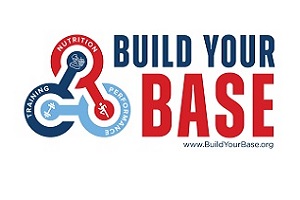Reflections and takeaways from 2013 Kultan Keihas, Chapter 1
Photos by Joy Kamani
Joy's gallery of 211 photos | Photo/Video Link page | NSAF Facebook page | Preview
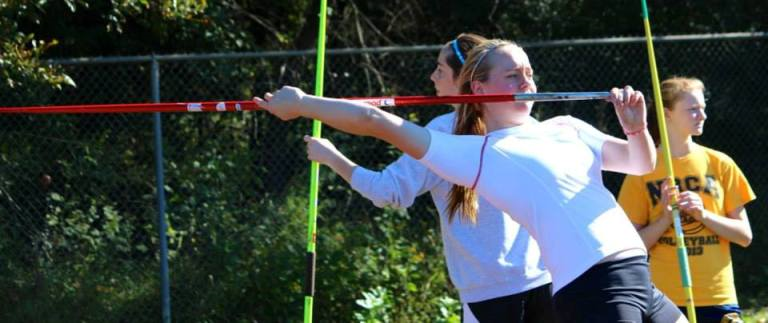
Consider the opportunity to hurl javelins through the blue sky, on a peaceful pitch surrounded by forest on a beautiful mid-fall day ... to absorb instruction and encouragement from a trio of coaches in your favorite event, including its most recent Olympic medalist, a young current Olympic contender and one of the event’s true proponents and gurus ... to enjoy and study rare video footage of the javelin’s great Olympic and World champions over several decades ... to engage one of the sport’s most creative circuit training setups, in an outdoor pavilion by a lake, feeling the organic roots of the event and its creative artistry ... and all with the rewards of a North Carolina outdoor barbecue and bonding with your training mates over the hilarity of an impromptu touch football game.
Could there be a better way to spend a fall weekend?
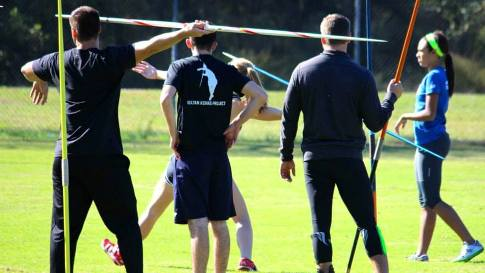 Not if you’re some of the nation’s premier prep and collegiate javelinists!
Not if you’re some of the nation’s premier prep and collegiate javelinists!
It was all part of the opening chapter of the Kultan Keihas Project Javelin – 2013-14 edition – hosted by said coach/guru/proponent Jeff Gorski in Chapel Hill, overseen and produced by the National Scholastic Athletics Foundation (NSAF), and attended by some of the nation’s brightest and most enterprising young throwers. From the opening classroom session Thursday night to the final throwing session Sunday morning, you could feel the love – the love the athletes, coaches and families have for this unique event in track and field, and the camaraderie they were building with each other.
The group of about 30 could hardly have been more diverse, including college seniors and 8th-graders, sister acts from Utah and Iowa, others from states ranging from New York to Louisiana to California, Oregon and Washington, javelin newbies and multi-eventers, coaches younger and older – and the families, all in various stages of understanding and appreciating this unique event.
And don’t get us wrong: Every event in our sport of track and field – from the distances, to the sprints and hurdles, to all of the jumps, vaults and rest of the throws – are special and sacred. It’s easy to imagine similarly great gatherings and experiences of harriers, long hurdlers, pole vaulters, shot putters or decathletes/heptathletes – or triple jumpers, as the NSAF and Coach Macka Jones will entertain at the Foundation’s November camp in Dallas.
But the javelin was declared an area of need by the NSAF back in 2011 – no American Olympic medalists since Project coach Bill Schmidt in 1972 and unrelated Kate Schmidt in 1976, after all. And it’s been abundantly clear to Gorski, the NSAF and the other leaders here that understanding and embracing what the rest of the world does – especially those from the event’s Mecca in Finland – is a key to long term success.
So the annual cycle of Kultan Keihas starts in Chapel Hill with November and December sessions (future dates and locations to be determined as new environs and schedules are considered) and concludes with the wonderful mid-summer week in Finland, where native coaches, an international training facility and wonderful competition await.
The camp included:
Three returning “Project” athletes
Katelyn Gochenour, Marian (Omaha, Neb.) soph – 156-8 PR (US#7 in 2013, #2 returnee for 2014
Trevor Danielson, Newberg (Ore.) senior – 206-5 PR in 2013 (US#8, #5 returnee)
Kristen Clark, Ruston (La.) senior – 139-5 PR in 2013
Three new “Project” athletes
Karen Bulger, NW Christian (Lacey, Wash.) senior – 161-5 PR (US#4, #1 returnee)
Tairyn Montgomery, Redondo Union (Redondo Beach, Calif.) soph – 155-9 PR (US#8, #3 returnee)
Emma Fitzgerald, Thayer Academy (Braintree, Mass.) soph – 149-5 PR (US#16, #6 returnee)
One heptathlete committed to the Project (save for Finland trip)
Alexa Harmon-Thomas, Lawrence Free State (Kans.) senior – 5,158 hept PR (US#3, #1 returnee), 82-7 javelin PR
Two prep domestic clinic athletes who have been here before
Chrissy Glasmann, Park City (Utah) junior – 135-0 PR
Kennedy Gochenour, Marian (Neb.) 8th-grader – 105-7 PR
Five prep domestic clinic athletes here for the first time
Sophia Rivera, Brentwood (Mo.) soph – 117-4 PR
Joshua Williams, Stroudsburg (Penn.) junior – 163-11 PR
Michael Marsack, Stroudsburg (Penn.) soph –138-0 PR
John Putnam, Massapequa (N.Y.) junior – 166-8 PR
Lauren Janok, North Raleigh Christian (N.C.) 8th-grader – 72-10 PR
Four collegiate athletes from Southeastern Louisiana U., here for the first time
Derek Hampton, junior – 225-3 PR
Andrew Bridge, soph – 187-11 PR
Jenna Baker, senior – 147-1 PR
Jordan Hartney, junior – 126-0 PR
Three collegiate coaches, also here for the first time
Chip Brundage, Pittsburgh
Lucais John MacKay, Southeastern Louisiana
Bambi Carson, Jacksonville
Providing the instruction was this formidable trio:
Jeff Gorski: The founder of Klub Keihas, former USATF Javelin High Performance chair. and coach of many Olympians, US record holder and other elites – and an elite himself in the 1970s and 80s with a best of 259 feet.
Bill Schmidt: 1972 Olympic javelin bronze medalist for USA, best of 283-2, 1978 US National Champion and coach of many U. of Tennessee All-Americans as well as other national/international level throwers.
Barry Krammes: A 2-time Olympic Trials finalist and current elite (training under Coach Gorski) at age 31 with a best of 259-1, he was 5th in the USATF Champs in 2013. He was also an All American at East Stroudsburg U. and currently teaches and coaches at East Stroudsburg South HS.
How to sum up all of the education and adventures that took place during four days with the athletes, coaches, families and NSAF staff is a formidable task. One way is to offer 10 takeaways from the weekend – on the event, the clinic experience, and the athletes – and let said athletes and coaches provide some of the comments:
1. Throwing a javelin far involves so much more than throwing a javelin
Maybe that’s the biggest thing. You grow up thinking you throw something the furthest by having the strongest arm. Of course, in reality, speed and footwork are vital in all of the track and field throws, but the significance of the leg-work in the javelin remains a secret to many of those not yet versed in some of the wisdom dispensed in this Project.
“Javelin is very unique, in that even though they term it a throw, it’s really not,” said Coach Gorski. “That’s the biggest change in the way Americans look at the event and the rest of the world does ... 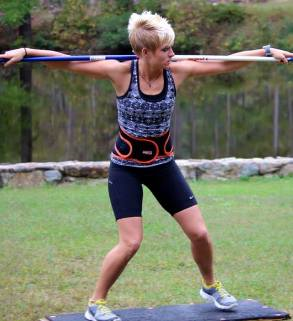 The runway work, and bounding and jumping, is very similar to what the horizontal jumpers do to the point that one the greatest javelin throwers in history, Janis Lusis (Latvian who won 3 Olympics medals for USSR, 1964-72) said throwing the javelin is long jumping with a stick in your hand.
The runway work, and bounding and jumping, is very similar to what the horizontal jumpers do to the point that one the greatest javelin throwers in history, Janis Lusis (Latvian who won 3 Olympics medals for USSR, 1964-72) said throwing the javelin is long jumping with a stick in your hand.
“That stuck to me as a really, really important concept in teaching the event, because it’s much more of a total body action, and the actual release and throw of the javelin is maybe worth 10-15 percent of the total distance that you throw. The rest of it comes out of your body and how you get it out of your body is what you do on the runway with your legs.”
“One of most important things I’ve learned, you have to focus on your form, you can’t just go out there and expect to muscle the javelin out there,” said Sophia Rivera. “You have to get your steps right.”
“Javelin training is weird, it’s a weird sport,” said Emma Fitzgerald. “Just the drills ... I would wake up and I was not able to move, my muscles were working in places that they’d never worked before. It was crazy, but I expected the unexpected and that’s what I got. It was awesome.”
2. There are many stories behind how these kids became jav throwers and many of them involve turbo javs
“My older cousin is a heptathlete, so for Christmas in 5th grade they got me a little turbo javelin and I was like, ‘Oh, what’s this? ... and it just escalated quickly,” recalled Katelyn Gochenour with a laugh. “The first year (however) was more like, cry before every practice and not want to go to anything ... and the year after that we started going to the practices regularly ... and the year following that, I actually won the Junior Olympics in the javelin and the discus.”
“It was towards the end of my freshman year, coming up on one meet that we were allowed to throw the javelin in my area (St. Anthony’s Invite), and my coach came out one day and he had a turbo javelin,” said John Putnam. “He’s like, ‘Here, throw this.’ So I threw it and he said, ‘All right, we’ll see.’
“So I came back the next week and we went to a field and we threw the actual javelin a couple of times. He was kind of impressed, so I was like, ‘All right, what’s going to happen?’ He said,
‘You’re going to throw it at the St. Anthony’s Invitational.’ So we go there, it was my first meet. I hadn’t thrown that much, but I threw 128 feet, 10 inches.”
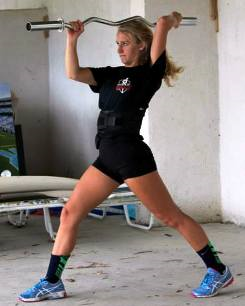 “In 8th grade, I competed with the Hersey track and field program and I did the softball throw there,” remembered Karen Bulger. “Then I moved on to doing the shot put in high school and my track coach was like, ‘Just throw the other events for fun.’ And I ended up throwing the javelin. I chucked it relatively far and it’s kind of progressed since then ... Who doesn’t want to throw a spear?”
“In 8th grade, I competed with the Hersey track and field program and I did the softball throw there,” remembered Karen Bulger. “Then I moved on to doing the shot put in high school and my track coach was like, ‘Just throw the other events for fun.’ And I ended up throwing the javelin. I chucked it relatively far and it’s kind of progressed since then ... Who doesn’t want to throw a spear?”
“I love all sports, but javelin just caught my eye at a real young age, like 9 probably,” said Fitzgerald. “My mom didn’t know why I wanted to do it, and I didn’t know either, but there was just this weird passion for it. That’s kind of how I got started with it and it’s been my strongest event every year.”
“I’d always played traveling softball growing up and had a pretty good arm, played shortstop, third base,” said Kristen Clark. But in 8th-grade, a jav-throwing friend convinced her to come out for track and, after trying all of the throws, she stuck with jav. Setting an 8th-grade record at her school of 119 feet didn’t put the sport at the top of her activities list, but then she won state at 136 feet as a frosh. “It opened my eyes that I’m kind of good at this and maybe I should really stick with this.”
3. Year-round effort is required for success at the highest level, so what you do in the off-season and between clinics is huge
Watching Trevor Danielson throw Friday was to see someone who’d obviously done a lot of work just since the Finland trip ended in July. It was to see someone who looks like they could throw 210, 220 or maybe better next spring. Much of that was the fruit of what he’d picked up in previous sessions and taken home. “A lot of workouts we do here, I’ve taken notes,” he said. “I’ve kind of kept those workouts in the back of my head, and I just do those quite a bit. I do have some of my own workouts I do, too. Running is a big part, I do a lot of running, weight training and then actually just a lot of throwing. I think that’s just one of the biggest things, just getting on the runway, getting your steps down, the run-up and actually just the throwing in general.”
Now, the athletes come from all sorts of backgrounds, with some from states that contest the event at the prep level and others from states that don’t. Danielson is absolutely in the former category: Not only does the jav thrive in Oregon (the home of the record-setting Crousers, for example), 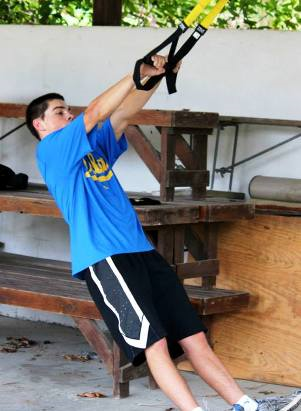 but at Newberg, Danielson trains under another coaching legend: Joe Boutin, whose proteges include former HSR-holder Rachel Yerkovich (176-5) and Cyrus Hostetler (205-2), both of whom were 2012 Olympians. In fact, those two were both seniors in 2005 and Hostetler wasn’t even the best on that team – that honor belonged to Alex Wolff, at 213-5.
but at Newberg, Danielson trains under another coaching legend: Joe Boutin, whose proteges include former HSR-holder Rachel Yerkovich (176-5) and Cyrus Hostetler (205-2), both of whom were 2012 Olympians. In fact, those two were both seniors in 2005 and Hostetler wasn’t even the best on that team – that honor belonged to Alex Wolff, at 213-5.
That’s the school record Danielson would like to break next spring. “I’ve had some good role models,” he says with a smile.
4. The veterans help the newbies, but they’re still learning themselves
“I feel like all of us are good enough athletes to adapt to (the throwing and circuit-training),” said Clark, “but what I’ve really been sharing with them the most is how cool of an experience this is, and how not to take it for granted and to really work hard for this – because this is just one of the most amazing things that’s ever happened to me.”
5. Even if you’re one of the best in the country, there’s a lot you can learn
“Everything was new for me, because I don’t quite have the proper technique down,” said Bulger, #1 in the U.S. going into 2014. “The crossovers were hard, and I guess the running, too ... really just trying to figure out what to do, how to tweak things perfectly. The whole weekend was kinda hard, but it was a good hard.”
“Going into this, I was kind of scared, I was like, ‘What if they change everything?’ said Tairyn Montgomery. “But actually they’ve been really helpful. They’ve been trying to keep my way of throwing so they’ve added on to what I do, too, so it’s really been amazing.
“I just like how they didn’t throw everything at me. Every time I threw, there was like one thing I could tweak and then if something happened the next throw, I could tweak that part. They did it slowly for me to understand so I could put it in the next time.”
6. The jav can be a family affair
You’d have to say the Crousers are still the first family of the javelin, but around Kultan Keihas sisters Katelyn and Kennedy head up Team Gochenour, and Chrissy keeps the Glasmann tradition going. The latter clan saw Megan move on to the college ranks this fall after her mighty 2013 campaign concluded with PRs at the Pihtipudas Javelin Carnival and the Pan Am Juniors. But Chrissy’s mom Niki, a former champion and 182-footer, joined her here and likely two more younger Glasmanns have Chapel Hill weekends in their future.
Chrissy Glasmann admits she loves winning and hopes to beat Megan’s 156-foot in-state record, but “I’ll definitely miss my sister ... I always loved being able to train and compete with her.”
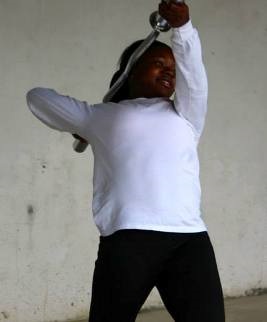 Kennedy is also acutely aware of the pros and cons of having an older sister ahead of her. “It goes both ways,” she said. “She wants to help me and with the Finland thing she taught me new things, but in the end we’re going to be competing against each other. Sometimes it’s tough being the younger sibling because you want to live up to what the older one is doing.”
Kennedy is also acutely aware of the pros and cons of having an older sister ahead of her. “It goes both ways,” she said. “She wants to help me and with the Finland thing she taught me new things, but in the end we’re going to be competing against each other. Sometimes it’s tough being the younger sibling because you want to live up to what the older one is doing.”
7. There’s great value, even for a multi-eventer
Alexa Harmon-Thomas is a great hurdler and horizontal and vertical jumper, good at the 200 and not really bad at the shot. But the javelin has brought her down in the heptathlon, dropping her from 5th to 21st at the World Youth Champs this past summer, for example. “That was a huge drop and so I really need improvement on that area,” she said.
So she had the courage to come here this weekend, even among athletes throwing 50-70 feet further, to sharpen up her weakest link as she prepares to chase things like Kendall Williams’ national record and a World Junior berth in 2014. So what was the weekend like for her?
“I didn’t know what to expect, but I did not think we would run as much as we did and I didn’t realize how weak I am in my arms,” she said with a rueful smile. “It’s interesting focusing on a weaker event. It’s a little bit frustrating, especially having everyone else here with this as their main event. But it’s really good to be around people who are good and competitive.”
8. Real camaraderie is built among the participants
It wasn’t hard to find the bonding taking place from the first night in the hotel, to the aforementioned touch football game by the lake, to the final goodbyes (but only until December) on Sunday.
That was a big part of what kept Harmon-Thomas going. “I really enjoyed being with them, we got really close, really fast,” she said. “I’m so excited to come back in December.”
“Probably the coolest part is just having these amazing people around,” said Montgomery, “and it’s just that everyone’s just not tense; it’s just fun and relaxing and everyone’s just friendly to everyone.”
“It’s unbelievable, it’s just as good as the first year, if not better,” said Danielson. “There’s a bunch of new people here; I love everyone out here. I’m so lucky to be out here with a wonderful group 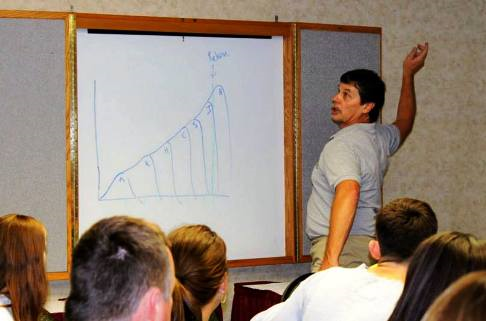 of kids and I’m very grateful.”
of kids and I’m very grateful.”
Said Michael Marsack: “It was just awesome, this group ... The kids are amazing, they’re really good athletes and nice people. And the coaches are beyond great, they know so much and have so much to teach.”
9. The coaches get a lot out of it, too
“It brings back the joy to (throwing the javelin), why you want to do it,” said Coach Krammes. “Sometimes you learn more from the kids, they also give back and teach you something. NSAF helps us, we help them; the kids help us and we help the kids. It’s unique in that way.”
10. This is a special group and there’s real hope for the future
“To see the dedication and work and focus that they have in the workouts, the warm-ups as well as the throws, it’s great to see ... and the dedication’s there,” said Coach Schmidt. “If they follow through and continue to train, they’ll succeed ... I think the key is we’ve gone ahead and literally sown the seeds ... hopefully they’ll be able to go ahead after college and be successful.”
“I’m impressed with the way they conduct themselves,” said Coach Krammes. “They all seem to really love and enjoy the javelin, and they want to get better. They understand what the program means to them, what it’s going to do for them and I believe they’re just taking the opportunity and going with it. It’s really neat to see that student-athletes this young are this passionate about something, and to see them going after it. And we’re able to enable their dreams a little bit and it’s really gratifying to help foster that.”
Finally, you look at someone like Katelyn Gochenour, who calls her Finland experience last summer (Pihtipudas MVP) “life changing” and, like Danielson, seems ready to just explode in this event with her off-season work. And you ask, what would she say to a random fellow javelinist that she might encounter at a meet and who hasn’t yet heard of Kultan Keihas?
“I would tell them to consider it, because it’s going to change their perspective – it’s gonna whether or not you want it to,” she said. “It’s gonna make it seem like javelin is a huge priority, let alone with the training and practices. You’re going to improve in four days, so obviously you’re going to want to do it again.”

